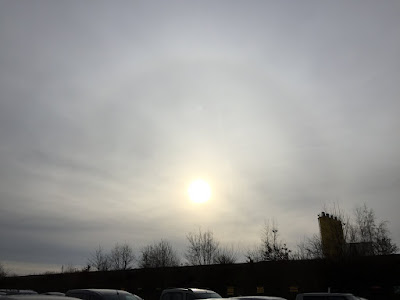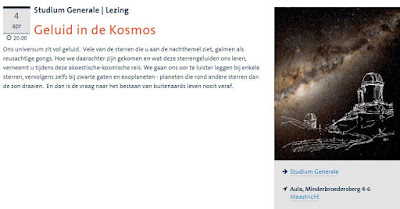Previous days it was difficult the find comet Iwamoto but as the comet is moving in front of M36 it's more easy.
Pascal Hilkens Astro Home Page
Thursday, February 28, 2019
C/2018 Y1 Iwamoto M36 M38 NGC1907 NGC1931
Wednesday, February 27, 2019
Owl Nebula M97 and Surfboard Galaxy M108
Leo Triplet M65 M66 and NGC3628
Three spiral Galaxies M65, M66 and NGC3628 in constellation Leo. The three are located at a distance of about 35 million light years from us.
The picture is a result of 46 photo's, each 30s exposure with Nikon D7500 on TLAPO 80/480 f/6. Raw pictures are converted into DNG and stacked using DeepSkyStacker. Final editing with CS4.
The picture is a result of 46 photo's, each 30s exposure with Nikon D7500 on TLAPO 80/480 f/6. Raw pictures are converted into DNG and stacked using DeepSkyStacker. Final editing with CS4.
C/2018 Y1 Iwamoto
Currently comet C/2018 Y1 Iwamoto is travelling through constellation Auriga and north of the open star cluster M36 (pictures will follow later).
Monday, February 25, 2019
The UFO Galaxy NGC 2683
The UFO Galaxy, NGC 2683 is located in the constellation Lynx at a distance of 25 million light years. The picture was taken with Nikon D7500 on TAL200K f/8.5. DeepskyStacker was used to stack the DNG pictures and final editing with CS4. Total exposure is 6 minutes and darks are set.
The "37" Cluster
NGC 2169 or The "37" Cluster is an open star cluster located at a distance of 3600 light years from us.
Sunday, February 24, 2019
Flame Nebula NGC2024
East from the belt of constellation Orion you can see the Flame Nebula or NGC2024. This emission nebula is located at a distance of 1350 light years from Earth.
The nebula was exposed for 9 minutes and all pictures stacked (DNG) with DeepskySkacker. Final editing using CS4. The bright star on the picture is Alnitak.
The nebula was exposed for 9 minutes and all pictures stacked (DNG) with DeepskySkacker. Final editing using CS4. The bright star on the picture is Alnitak.
Whirlpool Galaxy M51
The picture was taken with Nikon D7500 on TAL200K f/8.5. Deepskystacker is used to stack the pictures including darks. Final editing with CS4. No moon and temperature -1°C.
Moon Waning Gibbous (80%)
Saturday, February 23, 2019
Sun in H-Alpha
Filament on the Sun
This afternoon a huge filament is covering the Sun. This can be seen in H-Alpha. Picture is taken with Nikon D7500 on SolarMax3 d70/400 f/5.7. The insert is taken from the Gong H-Alpha network.
Monday, February 18, 2019
Flame Nebula
Flame Nebula during a waxing gibbous moon (90%). The horsehead nebula is too faint as the moon is shining out the famous nebula.
Picture taken with Nikon D7500 on TLAPO 80/480 f/6 ISO800 and 46 minutes exposure. Stacking with DeepSkyStacker and final editing with CS4.
Picture taken with Nikon D7500 on TLAPO 80/480 f/6 ISO800 and 46 minutes exposure. Stacking with DeepSkyStacker and final editing with CS4.
Supermoon Coming
Jupiter Venus and Saturn in the morning sky
Sunday, February 17, 2019
Sun in H-Alpha
No sunspots today and only small prominences on the Sun. On the other hand one big filament on the disk. The picture was taken with Nikon D7500 on SolarMax 70/400 DS BS15 and editing using CS4. The get the picture sharpened, it is set as black/white.
Saturday, February 16, 2019
NGC3115 Spindle Galaxy and Millenium Galaxy Catalogue MGC
When looking at my astropicture of NGC3115, the Spindle Galaxy, I saw a blur south of the galaxy. At first I was thinking of a camera fault but when uploading the picture in Astronometry it showed aswell a blur as a result. Interesting in fact, astronometry did not put any reference. So I started searching around and found the NGC3115 galaxy to be associated with two galaxies of which one is MGC-1-26-21, located exactly on the same spot as on my picture.
Astropictures DeepSky Objects
So I decided to talk some pictures of some Deep Sky object. They are not perfect due to the Moon. Pictures are taken with TAL200K f/8.5 and Nikon D7500. No darks were taken and pictures are stacked with DeepSkyStacker (format DNG). CS4 was used for final editing.
- Messier M46 : Open Star Cluster with Planetary Nebula NGC 2438
- Messier M48 : Open Star Cluster
- Messier M81 : Galaxy
- Messier M65 and M66 : Galaxy
- Messier M67 : Open Star Cluster
- NGC 1545: Open Star Cluster
- Messier M42 :Orion Nebula
- NGC 2903 : Galaxy
- NGC 3115 : Galaxy, with a black hole of 2 billion Sunmasses!
Regulus
Alpha Leonis or Regulus is a star located about 79 light years from our Sun. The picture was taken with a Bathinov Mask in prepartion of deep sky photography.
Orion Nebula Messier M42
A clear sky and almost full Moon. So not perfect for deep sky objects, but still I was able to shoot the Orion Nebula Messier M42. The bright nebula was taken using Nikon 7500 on TAL200K. Editing of Jpeg with CS4.
Friday, February 15, 2019
How huge are prominences
This afternoon the Sun was covered with huge prominences. But how huge? I made some calculations and draw Earth next to the large prominence.
Gigantic Filament on the Sun
This afternoon I could observe some huge filaments or prominences. Observations done with SolarMax3 70/400 DS BF15 and pictures taken with Nikon D7500. Limited editing using CS4.
Thursday, February 14, 2019
Tuesday, February 12, 2019
Moon Phase and Libration
All details like the geocentric phase, libration, position angle of the axis, and apparent diameter of the Moon throughout the year 2019, at hourly intervals can be seen via NASA Scientific Visualisation Studio through this link.
When entering the date and hour, just download the picture is this what you get :
What's happening with the camera industry
Not so good news from the camera industry. Decrease continious and mirrorless market is not picking up (yet).
Monday, February 11, 2019
Comet Iwamoto in constellation Leo
This morning a clear sky and perfect to make wide field picture of Comet C/20118 Y1 Iwamoto. The comet is not visible with the naked eye and even difficult to find in the picture.
Sunday, February 10, 2019
Comet C/2018 Y1 Iwamoto
The next days, take a look at the sky and search for Comet C/2018 Y1 Iwamoto. The comet can be seen (using a binocular) near and in the constellation Leo, the Lion. The brightness or magnitude depends on the the source and varias between 10.75 (The Sky live), 8.5 (Heavens Above) and 6.7 (Bright Comets). Closest approach is between Feb12 -13.
 |
| Credit Heavens-Above |
Stars during the Total Lunar Eclipse of Jan 21
Picture taken of the sky around the full moon, during totality of the Total Lunar Eclipse of Jan 21, 2019. Picture taken using Nikon D7500 on TLAPO80/480 f/6 setting ISO200 for 8s. Raw converting to DNG and editing with CS4.
Monday, February 4, 2019
Friday, February 1, 2019
Weather Summary January 2019
January had 13 days with temperatures falling below 0°C during daytime and the lowest temperature so far of -10,4°C. Rainfall was avg with almost 70l/m2 and avg temperature was 3°C less then last year 2018 but comparable with the years 2014-2017.
BBC Sky at Night : Get stargazing with Back Garden Astronomy Week
If so, Back Garden Astronomy Week is the perfect time to get outside and get looking up at the night sky.
From Saturday 2 - Sunday 10 February we’re inviting people with curious minds, families with kids who love space and those who’ve always wanted to get started in stargazing to join our week-long campaign.
Sign up for free and each day we'll send you an email newsletter that will help you discover a new sight every night.
We'll show you how to find some of the beautiful objects visible in the night sky, all of which can be seen from your back garden with just a pair of binoculars.
You'll also receive essential observing tips that beginners need: advice like how to get your eyesight used to the dark, how best to navigate the night sky and which are the best targets to see.
See the website via this link.
Studium Generale Maastricht - Geluid in de Kosmos
Prof. Dr. Katrien Kolenberg van de KU Leuven zal een lezing geven rond het thema "Geluid in de Kosmos". De lezing kadert in de lezingenreeks van Studium Generale van de Universiteit van Maastricht en vindt plaats op donderdag 4 April om 20h00.
Subscribe to:
Posts (Atom)










































